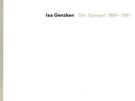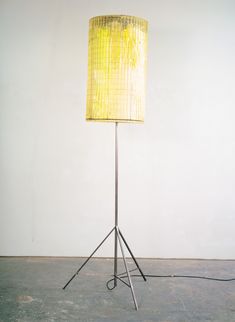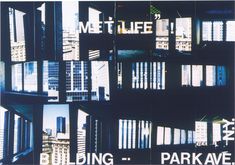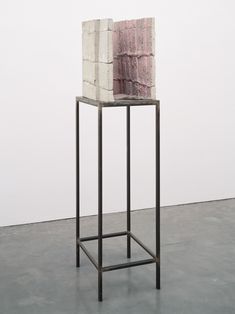Isa Genzken
Isa Genzken was born in Bad Oldesloe, Germany, in 1948. From 1969 to 1971 she studied painting at the Hochschule für Bildende Künste in Hamburg with Almir da Silva Mavignier and from 1971 to 1973 at the Hochschule für Bildende Künste in Berlin. In 1972 she expanded her studies to include art history and philosophy at the University of Cologne, studied photography and graphic arts at the Hochschule der Künste in Berlin until 1973, and at the Staatliche Kunstakademie Düsseldorf until 1977. In 1977 she received a travel scholarship from the Düsseldorf Art Academy to the United States. In 1978-1980 she was a Karl Schmidt Rottluff scholarship holder. In 1980 Isa Genzken received the Berlin Art Prize. In 2002, the Museum Ludwig in Cologne honored her with the Wolfgang Hahn Prize. In 2004 she received the International Art Award of the Cultural Foundation Stadtsparkasse Munich. In 2009, she was the recipient of the Yanghyun Prize of the Yanghyun Foundation, Seoul. In 2017, Genzken was awarded the Goslar Kaiserring. In 2019, she was awarded the Nasher Prize by the Nasher Sculpture Center, Dallas. Isa Genzken lives and works in Berlin after extended stays in Cologne and New York.
Genzken's first solo exhibition took place in 1976 at the Konrad Fischer Gallery in Düsseldorf. Numerous solo exhibitions at renowned international museums as well as participation in major exhibitions such as "Skulptur. Projekte Münster" or Documenta IX, 1992 and 11, 2002 followed. In 2013, the Museum of Modern Art, New York dedicated a comprehensive retrospective to her, which was taken over by the Museum of Contemporary Art, Chicago and the Dallas Museum of Art, Dallas, USA
Isa Genzken’s work displays the greatest possible variety of references to architecture and industrial design as she continues to surprise her public time and again with new groups of works. “I find the rough-outer-shell constructions of new buildings most interesting, because they reveal the engineers’ rational thinking behind them, which has a great deal more to do with truth compared to the routine covering of the façades with pseudo-noble materials,” the artist is quoted as saying. Among other things, her references to 1920s constructivism and functionalism shows up most clearly in her computer-generated, geometrically constructed ground sculptures, the Hyperbolos and Elipsoiden of the late 1970s and early 1980s. In the photographs of her Hi-Fi-Serie (1979), Genzken reproduced advertisements for stereo phonographs, which were deemed highly desirable by art collectors at the time. The four advertising objects, each from a different maker, originating from separate industrialized nations with separate official languages, were photographed and reproduced with such hard contrasts that they became readable as constructivist design works in their own right.
The group of works made from plaster of Paris, negatives of miniature sculptures, and the later fragments made of concrete, have been positioned by the artist on bases or metal stands so that viewers are able to inspect them as they would an architectural model. The next phase of her work is in the window sculptures and other architectural or interior design quotations made from epoxy resin casts, such as column or lamp sculptures, but also lamp images. In her exhibition titles Isa Genzken likes to focus on architecture in a social context, as, for example, in Vom 23. Stock aus (Viewed from the 23rd Floor), Jeder braucht mindestens ein Fenster (Everybody Needs At Least One Window) or MetLife, as her retrospective at the Generali Foundation was entitled, citing an insurance company’s advertising inscription on a central building in New York that was created by Walter Gropius. Genzken also likes to make personal materials and messages available to the public, as in X-Rays (1981), showing enlarged x-ray photographs of the artist’s head, or in the reinforcements of the lamp in Lampe (1996), which represents the temperature curve of the artist‘s body in a notation readable only to the cognoscenti.
Public projects have taken up a fairly significant part of Genzken’s work, in an active involvement that goes back to the 1980s. I Love New York, Crazy City (1995-96) is the title of three extraordinary books of collages which emerged during a phase of active self-discovery under the influence of the tremendous dynamics of the city of New York and so contain different documents of the artist’s day-to-day life, such as hotel and restaurant bills, photographs, and so forth. These books formed the starting point for a new group of works. Since the end of the second half of the 1990s, Genzken has been conceptualizing sculptures and panel paintings in the shape of a bricolage of materials taken from DIY stores and from photographs and newspaper clippings. (SB)
Books of artists
Isa Genzken. Isa Genzken. Der Spiegel 1989-91. Köln: Buchhandlung Walther König, 2003.

Isa Genzken. I love New York, crazy city. Ed. Genzken, Isa; Ruf, Beatrix. Text by Ruf, Beatrix. New York: Ringier, 2006.
Isa Genzken. Mach dich hübsch. Stedelijk Museum, Amsterdam. Köln: Verlag der Buchhandlung Walther König, 2015.
Artworks

Birne, 1984

Bismarckstraße, 1994

Chicago Drive, 1992

Hi-Fi Series, (Technical Research), (Hitachi), (Akai), (Front Operation), 1979

I Love New York, Crazy City, 1996

I Love New York, Crazy City, 1996

I Love New York, Crazy City, 1996

Lampe, 1996

Met Life, 1997

Rosa Zimmer, 1987

Zwei Frauen im Gefecht, 1974